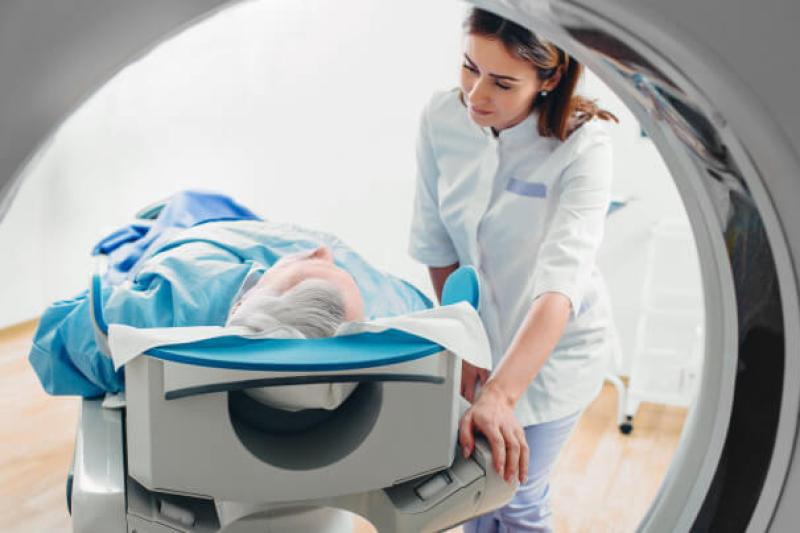- AdventHealth University

Doctors often rely on medical imaging to diagnose torn shoulder muscles, monitor the progression of a pregnancy, or plan treatment for a tumor. Medical imaging allows healthcare providers to gather vital information about injuries, diseases, and treatments.
From ultrasounds to X-rays, medical imaging can help keep people healthy and save lives. In the last 20 years, advancements in technology have increased the capabilities and accuracy of medical imaging, allowing doctors to choose the best therapies and provide patients with peace of mind.
However, doctors can’t gather this essential information on their own. Medical imaging equipment requires expert handling by medical professionals with the proper training and skills, such as radiologic and ultrasound technologists. While both types of technologists play a vital role in helping doctors diagnose and treat patients, they do so in unique ways.
Those interested in the imaging field should consider the differences between a radiologic technologist vs. ultrasound technologist to determine which career option inspires them more.
Similarities and Differences
Radiologic and ultrasound technologists enjoy rewarding careers in delivering key information to doctors. The work of both types of technologists can involve:
- Preparing and maintaining medical equipment
- Capturing images
- Reviewing image quality
- Ensuring images capture the correct areas of the body
Both technologists also interact with patients. Those patients may not be familiar with the tests, or they may feel nervous and uncomfortable. Radiologic and ultrasound technologists are responsible for:
- Familiarizing patients with procedures
- Reassuring patients
- Answering patient questions
- Giving patients clear instructions
- Positioning patients to capture needed images
Radiologic and ultrasound technologists work in similar environments, such as hospitals, doctor’s offices, or outpatient care centers. Additionally, both types of technologists split their time between interacting with patients and completing technological tasks.
The primary difference between a radiologic technologist vs. ultrasound technologist relates to the technology each one uses. Radiologic technologists typically operate equipment that uses radiation to create medical images. Ultrasound technologists, on the other hand, operate equipment that uses high-frequency sound waves to generate images. Each type of equipment calls for specialized training.
Radiologic Technologists
Radiologic technologists, also known as radiographers, work with doctors in diagnosing diseases and injuries. They may use X-ray machines and prepare contrast agents that patients drink to allow soft tissue to appear brighter in images. They may also assist doctors in interventional imaging procedures. Radiologic technologists often go on to specialize in areas including the following:
- Computed Tomography (CT). This procedure involves placing patients on a motorized table that moves into the CT imaging system. As the patient passes into the scanner, a rotating X-ray unit captures image slices that the machine stacks together. The process allows physicians to examine the inside of an organ, layer by layer.
- Magnetic Resonance Imaging (MRI). This procedure involves placing patients on a table that slides into an MRI machine. The equipment uses a strong magnet and pulsing radio waves to disrupt the alignment of atoms in the patient’s body. After the pulsing stops, the atoms return to normal, giving off signals that the MRI machine turns into detailed images. One benefit of MRI scans is that they don’t use radiation, which can have harmful effects.
- This procedure involves placing the breast on a platform of the mammography imaging unit. The breast is compressed, and an X-ray tube is used to capture tissue images. An advanced technique called digital breast tomosynthesis creates 3D representations. The procedure exposes the body part to a low dose of ionizing radiation, which the machine measures, processes and turns into images.
Education and Skill Requirements
Most radiologic technologists hold at least an associate degree that covers subjects including anatomy, radiation physics, radiation protection, pathology, and image evaluation. However, by earning a Bachelor of Science in Imaging Sciences, radiologic technologists develop skills that can help them lead imaging departments, learn advanced imaging modalities, gain a competitive advantage, and command higher salaries.
To operate equipment that emits radiation, radiologic technologists must be licensed in the states where they work, depending on the specific state requirements. They also often need certification from a credentialing organization like the American Registry of Radiologic Technologists.
Radiologic technologists need excellent interpersonal skills to work well with patients. They also need strong technical and mathematical skills to operate complex machinery. Additionally, radiologic technologists must be detail oriented to ensure they capture the correct images with accuracy, maintaining balance between high image quality and using the lowest possible dose of radiation.
Roles and Responsibilities
The specific duties of radiologic technologists include the following:
- Follow precise physician orders regarding which parts of a patient’s body to X-ray
- Recall and follow imaging protocols to produce high quality images
- Operate radiographic equipment such as X-ray machines and CT equipment
Radiologic technologists also carefully record patient details. They may discuss images with radiologists and other medical staff to decide if additional images are needed.
Job Outlook
The number of radiologic technologist positions is expected to grow by 9% by 2028, according to the U.S. Bureau of Labor Statistics (BLS). Demand for the profession should increase as the population ages and doctors need more diagnostic images for conditions such as cancer.
Ultrasound Technologists
Ultrasound technologists, also known as diagnostic medical sonographers, use sonography, a noninvasive, painless method that produces images of soft tissues, blood flow, organs, and blood vessels. The process involves beaming high-frequency sound waves into the body that bounce off a patient’s organs or tissues, creating electrical signals. The ultrasound machines then process those signals and transform them into images.
Ultrasound technologists can specialize in several areas of sonography, including:
- Obstetrics and Gynecology. This type of sonography creates images of fetuses in the womb, allowing doctors to monitor development and detect any abnormalities. Additionally, sonographers in this subdiscipline facilitate the diagnosis of ectopic pregnancies, ovarian cysts, and other health issues.
- This type of sonography allows ultrasound technologists to create images of the heart, providing cardiologists with a view of the heart’s valves and enabling them to locate abnormalities. Doppler imaging, a form of ultrasound technology, analyzes blood flow’s path and velocity as it passes through blood vessels and the heart.
- Musculoskeletal Sonography. This type of sonography creates images of injuries to joints, muscles, and ligaments otherwise hidden by dense bone tissues. Musculoskeletal sonography offers real-time images of joints and soft tissues that allow orthopedic doctors to diagnose and treat injuries.
Educational and Skill Requirements
Like radiologic technologists, ultrasound technologists don’t need a bachelor’s degree. However, completing one holds significant advantages. Beyond offering a more developed knowledge of sonography, a Bachelor of Science in Imaging Sciences builds management skills that may make ultrasound technologists more attractive job candidates.
Most employers require one or more certification in a specialty area, such as those offered by the American Registry for Diagnostic Medical Sonography. Additionally, some states require ultrasound technologists to obtain a license.
Ultrasound technologists must have excellent listening and verbal skills to effectively communicate with doctors and patients. They also need critical thinking skills to evaluate the best techniques to use for various diagnostic procedures.
Roles and Responsibilities
The specific duties of ultrasound technologists include the following:
- Preparing patients for procedures and taking medical histories
- Analyzing diagnostic information and summarizing finding for doctors
- Distinguishing between abnormal and normal images
- Operating ultrasound equipment and transducers (scanning probes)
Ultrasound technologists also communicate and collaborate with physicians before, during, and after procedures.
Job Outlook
Ultrasound technologists can expect a promising job market. Positions in the field will increase by 19% by 2020, according to the BLS. As with radiologic technologists, increased demand will likely stem from an aging population.
Explore the Benefits of Earning a Bachelor of Science in Imaging Sciences
Medical imaging plays a vital role in diagnosing and treating injuries and illnesses. Gaining the necessary skills to become an imaging technologist requires the right education. AdventHealth University Online offers a comprehensive program in imaging sciences that prepares radiologic and ultrasound technologists to succeed and advance in their fields. With several specialized tracks including imaging leadership, interdisciplinary, CT, MRI, vascular interventional, and sonography, students can focus on what interests them most.
Considering a career in medical imaging? Learn more about the difference between radiologic technologist vs. ultrasound technologist and discover how AdventHealth University Online’s Bachelor of Science in Imaging Sciences can help advance a rewarding career in the diagnostic imaging field.
Recommended Readings
Health Imaging for Women: Medical Applications, Benefits, and Careers
Exploring Sonography Careers: How to Become a Cardiac Sonographer
Exploring Sonography Careers: What Is Pediatric Sonography?
Sources:
American Association of Radiologic Technologists, Careers in Radiologic Technology
American Registry of Radiologic Technologists, What Do Radiologic Technologists Do?
British Society of Interventional Radiology, “What Is Interventional Radiology?”
Healthline, Sonogram vs. Ultrasound
Houston Chronicle, “Radiology Tech vs. Ultrasound Tech”
Houston Chronicle, “What Are the Different Fields of Sonography?”
Medical Design & Outsourcing, “Advancements in Medical Imaging Technology”
Peconic Bay Medical Center, The Important Role Medical Imaging Plays in Diagnosis and Treatment
RadiologyInfo.org, Breast Tomosynthesis
The Balance, “What Does an Ultrasound Tech Do?”
U.S. Bureau of Labor Statistics, Radiologic and MRI Technologists
U.S. Food and Drug Administration, “What is Computed Tomography?


